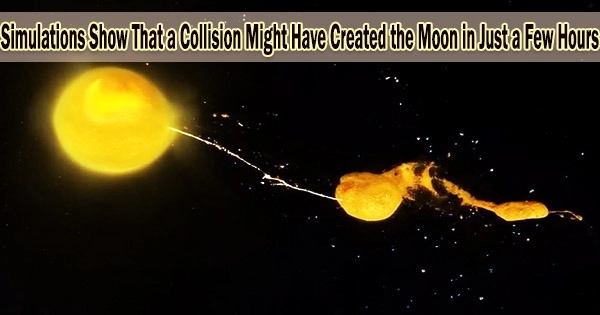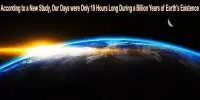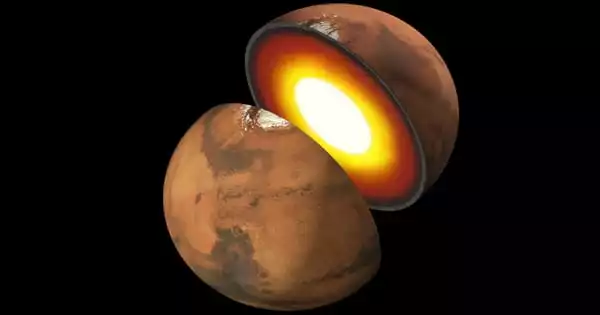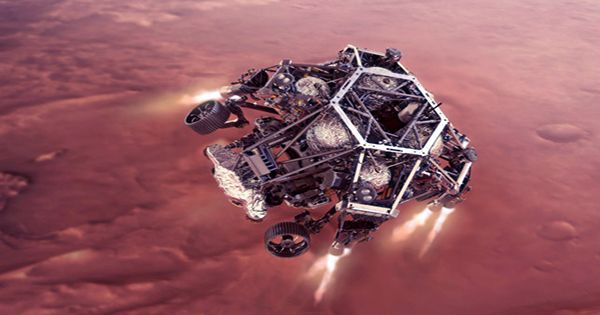It is currently believed by many scientists that the Moon formed as a result of a collision between the early Earth and a Mars-sized object that occurred around 4.5 billion years ago. This collision is thought to have occurred shortly after the formation of the solar system, and it is believed that the impact would have been so powerful that it could have created the Moon in just a few hours.
When an object called Theia, which was roughly the size of Mars and collided with a version of our Earth that looked significantly different from the one we live on today, the Moon was created. Without a clear solution, scientists have spent decades trying to figure out how precisely that formation took place.
According to the majority of ideas, the Moon developed from the collision’s debris over the course of several months or years. According to a recent simulation, the Moon might have formed quickly in a matter of hours when material from the Earth and Theia was shot straight into orbit following the impact.
“This opens up a whole new range of possible starting places for the Moon’s evolution,” said Jacob Kegerreis, a postdoctoral researcher at NASA’s Ames Research Center in California’s Silicon Valley, and lead author of the paper on these results published in The Astrophysical Journal Letters. “We went into this project not knowing exactly what the outcomes of these high-resolution simulations would be. So, on top of the big eye-opener that standard resolutions can give you misleading answers, it was extra exciting that the new results could include a tantalisingly Moon-like satellite in orbit.”
The simulations employed in this study rank among the most in-depth of their kind and operate at the highest resolution of any simulation done to investigate the Moon’s formation or other massive impacts.
Having access to more computer capacity allowed researchers to see novel behaviors arise in a way that earlier studies simply were unable to. This indicated that lower-resolution simulations can lose out on essential elements of these kinds of encounters.
The more we learn about how the Moon came to be, the more we discover about the evolution of our own Earth. Their histories are intertwined and could be echoed in the stories of other planets changed by similar or very different collisions.
Vincent Eke
A Puzzle of Planetary History
It is necessary to use the Moon’s mass, orbit, and careful study of lunar rock samples in conjunction with scenarios that could have resulted in what we see now to understand the Moon’s beginnings.
Some characteristics of the Moon, such its mass and orbit, could previously be explained pretty well by conventional theories, albeit with some significant limitations. Why the Moon’s composition is so similar to that of the Earth has long been a mystery.
The isotopic signature of a material, a chemical indicator of how and where an object was generated, allows scientists to investigate the composition of a material. In contrast to rocks from Mars or other parts of the solar system, the lunar samples that scientists have been able to analyse in labs exhibit isotopic signals that are quite similar to rocks from Earth. This suggests that a significant portion of the Moon’s composition originated on Earth.
It’s less probable we’d see such high similarities in earlier scenarios where Theia spewed out into orbit and mingled with only a little amount of material from Earth, unless Theia was likewise isotopically similar to Earth, an unusual coincidence. According to this hypothesis, the Moon was formed mostly from Earth material, which could assist to explain why its outer layers are comparable to those of the Earth.
Other explanations for these compositional similarities have been put forth, such as the synestia model, in which the Moon is formed inside a swirl of vaporized rock following the collision, but these explanations may have difficulty explaining the Moon’s present orbit.
This single-stage, quicker formation hypothesis provides a clearer and more elegant solution to both of these open questions. It might also offer fresh approaches to solving other riddles that haven’t been solved.
One of the most intriguing theories for the Moon’s beginnings to date, this scenario might send the Moon into a broad orbit with an interior that isn’t totally molten, thus explaining features like the Moon’s tilted orbit and thin crust.
Analyzing upcoming moon samples that NASA’s upcoming Artemis missions will return to Earth for investigation will help us get closer to determining which of these possibilities is true.
Scientists will be able to assess how real-world data stacks up to these simulated scenarios and what they reveal about how the Moon has changed over its billions of years of history as they acquire access to samples from other regions of the Moon and from deeper beneath its surface.
A Shared Origin
These studies can help us learn more about the Moon, but they can also help us comprehend how our own planet, Earth, got to be the planet that supports life as we know it today.
“The more we learn about how the Moon came to be, the more we discover about the evolution of our own Earth,” said Vincent Eke, a researcher at Durham University and a co-author on the paper. “Their histories are intertwined and could be echoed in the stories of other planets changed by similar or very different collisions.”
Collisions abound in the cosmos. The formation and evolution of planetary bodies depend heavily on collisions. On Earth, we are aware that the collision with Theia and other historical events played a role in its ability to acquire the raw components for life.
The more accurately scientists can mimic and decipher the processes involved in these collisions, the better equipped we are to comprehend how a planet might develop into one that is habitable like our own Earth.
This research is a collaborative effort between Ames and Durham University, supported by the Institute for Computational Cosmology’s Planetary Giant Impact Research group. The simulations used were run using the open-source SWIFT, (SPH with Inter-Dependent Fine-grained Tasking) code, carried out on the DiRAC (Distributed Research Utilizing Advanced Computing) Memory Intensive service (“COSMA”), hosted by Durham University on behalf of the DiRAC High-Performance Computing facility.
















